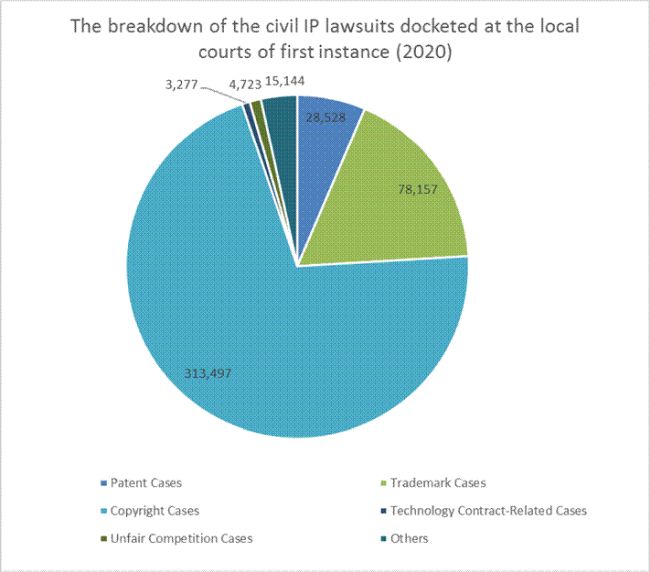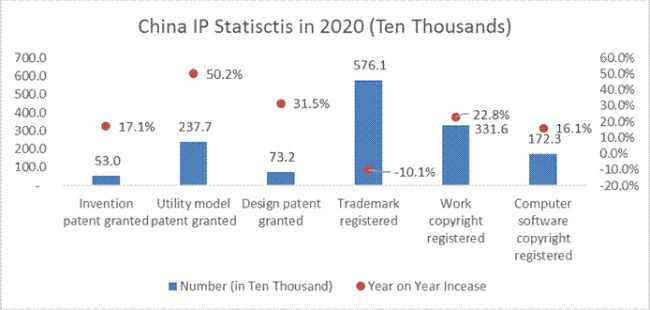As president Xi Jinping made the remarks in a speech on November 30, 2020 "Innovation is the primary driving force behind development, and protecting IPR is equal to protecting innovation", China is paying much attention to the protection of IPR.
The legislatures in China have been amending laws and among other things, introduced punitive damages for IP infringement acts. The courts in China have been striving to effectively improve trial quality and efficiency, aimed at dispensing perceptible fairness and justice and strengthening judicial protection of IP rights. The Supreme People's Court of the People's Republic of China (SPC) have been issuing judicial interpretations on applications of law in IP litigations and constructed a guidance system by publishing guiding cases and typical cases to improve quality of trials and ensure uniform and consistent applications of law in IP-related trials. The Chinese IP law enforcement authorities have been taking aggressive actions against IP infringements. All of these efforts have resulted in enhancing IP protection in China, helping the IPR right holders to build a stronger IP-based moat for their businesses and creating a competition environment friendly to the IP right holders.
- IP litigations in China
In 2020, a total of 3,470 civil IP litigations were docketed and 3,260 lawsuits were concluded by the Supreme People's Court, respectively 38.58% and 64.98% higher than the cases in 2019. In 2020, the local courts across China docketed 443,326 civil IP litigations of first instance and concluded 442,722 lawsuits, respectively 11,1% and 12.22 higher than the previous year.
|
Category |
Number |
Increase/decrease rate compared to the IP litigations in 2019 |
|
Patent |
28,528 |
28.09%↑ |
|
Trademark |
78,157 |
19.86%↑ |
|
Copyright |
313,497 |
6.97%↑ |
|
Unfair competition |
4,723 |
14.14%↑ |
|
Technology contract disputes |
3,277 |
4.53%↑ |
|
Other civil IP disputes |
15,144 |
34.96%↑ |
Source: SPC Annual Report on Intellectual Property Protection by Chinese Courts in 2020
The breakdown of the civil IP lawsuits docketed at the courts of first instance

Source: SPC Annual Report on Intellectual Property Protection by Chinese Courts in 2020
The local courts docketed 42,975 civil IP litigations of second instance and concluded 43,511 lawsuits with a decrease of 13.54% and 10.67% respectively compared to 2019.
High-profile civil IP litigations heard by the courts in 2020 include: multiple lawsuits between Huawei Technology Co., Ltd., et al. and Conversant Wireless Licensing S.a.r.l, involving disputes over confirmation of non-infringement of patent rights and standard essential patent license, Red Bull Vitamin Beverage Co., Ltd. v.s. T.C. Pharmaceutical Industries Co., Ltd., et al. over trademark ownership dispute and etc.. In the trade secret infringement lawsuit between Jiaxing Zhonghua Chemical Co., Ltd., et al and Wanglong Group, et al, the trial court awarded damages at the amount of 3.5 Million RMB Yuan to the plaintiffs whereas the plaintiffs claimed damages at the amount of 502 Million RMB Yuan. As the appellate court, the Supreme People's Court awarded damages at the amount of 159 Million RMB Yuan to the appellants/plaintiffs, which have been the highest amount of damages awarded in trade secret infringement cases in China up till now. The verdict issued by the Supreme People's Court in this case demonstrates the determination of the court in protecting trade secrets and fighting against malicious trade secret infringers.
In 2020, the Supreme People's Court docketed 1,909 administrative IP cases and concluded 1,735 administrative IP cases with an increase of 79.08% and 96.27% respectively compared to 2019. The local courts accepted 18,464 administrative IP lawsuits of first instance, 14.44% higher than 2019 and 17,942 IP lawsuits of the first instance were concluded, 4 cases more than in 2019.
The breakdown of the administrative IP lawsuits docketed at the courts of first instance
|
Category |
Number |
Increase/decrease rate compared to the administrative IP litigations in 2019 |
|
Patent |
1,417 |
14.69%↓ |
|
Trademark |
17,035 |
17.83%↑ |
|
Copyright |
12 |
4 case less than in 2019 |
Source: SPC Annual Report on Intellectual Property Protection by Chinese Courts in 2020
The local courts accepted 6,092 administrative IP lawsuits of second instance and concluded 6,183 administrative IP lawsuits of second instance with a decrease of 16.59% and an increase of 4.06% respectively compared to 2019. Among the concluded cases, the judgments were affirmed in 4,828 cases and reversed in 1,214 cases, 2 cases were remanded for retrial, 114 cases were withdrawn, and 4 cases were dismissed.
High-profile administrative IP lawsuits heard by the courts include: Apple Computer Trading (Shanghai) Co., Ltd. vs. CNIPA and Shanghai Zhizhengshineng Network Technology., an administrative retrial case over invalidation of an invention patent; Budweiser Harbin Beer Co., Ltd. v.s. CNIPA, an administrative case over official rejection of trademark application.
In 2020, the local courts accepted 5,554 and concluded 5,520 IP-related criminal litigations of first instance with an increase of 5.76% and 8.77% respectively compared to 2019. Among them, there were 5,203 criminal lawsuits related to infringement of registered trademarks, 4.44% higher than 2019 and 288 criminal lawsuits of copyright infringement, 37.14% higher than 2019 .
The breakdown of criminal IP litigations concluded at the courts of first instance in 2020
|
Category |
Number |
Increase/decrease rate compared to 2019 |
|
Counterfeiting registered trademarks |
2,260 |
5.9%↑ |
|
Selling products bearing counterfeit registered trademarks |
2,528 |
10.93%↑ |
|
Illegally manufacturing and selling illegally manufactured registered trademarks |
395 |
6.62%↓ |
|
Patent counterfeiting |
2 |
|
|
Copyright infringement |
273 |
42.93%↑ |
|
Selling infringing copies of copyrighted works |
17 |
9 more cases than in 2019 |
|
Trade secret infringement |
45 |
6 more cases than in 2019 |
For IP-related criminal litigations of second instance, 869 cases were docketed by the local courts and 854 cases were concluded, up 7.55% and 5.82% respectively than 2019.
The high-profile criminal IP lawsuits heard by the courts in 2020 include: criminal lawsuit against Li Haipeng and 9 other defendants for copyright infringement; criminal lawsuit against Zhenjiang Huaye Automobile Products Co., Ltd. and 6 other defendants for selling products bearing counterfeit registered trademark and criminal lawsuit against Jiang Jiahui and 6 other defendants for trade secret infringement.
The courts are awarding damages at substantive amount to the IPR right holders and have applied punitive damages to intentional infringement of IP rights. In the trademark infringement and unfair competition lawsuit between Xiaomi Technology Company, et al and Zhongshan Pentium Company, et al, the Jiangsu High People's Court supported the full amount of the damages at 50 Million RMB Yuan claimed by the plaintiffs. The Hangzhou IP court applied punitive damages to the infringer who maliciously infringed upon the internationally famous trademark "Wyeth", the amount of damages awarded by the court of first instance was as high as 30.55 Million RMB Yuan.
- Administrative IPR enforcement actions in China
In 2020, the AMRs (Administration for Market Regulation) processed 7,100 patent infringement cases, 29,600 trademark infringement cases and 7,371 unfair competition cases. The AMRs handed over 811 trademark infringement cases to the local police and procuratorates so as to support the procuratorates in pressing criminal charges against the trademark infringers. In response to the letters from Danish Embassy and German Embassy on infringement of the trademarks "GRUNDFOS" and "BURGMANN" involving 18 companies as suspected infringers in 12 cities and 9 provinces, the State ARM organized an ad hoc enforcement campaign and during the raid actions, the infringing products were found on the premises of 9 companies, 3,665 sets of the infringing products and 3,679 pieces of packaging were seized.
In 2020, the copyright law enforcement authorities took down 3.24 Million infringing links and shut down 2,884 infringing APPs and processed 724 online copyright infringement cases and among them, there were 177 criminal cases. The Chinese custom authorities took 653,000 customs seizure actions against the IPR infringers.
On March 21, 2021, CNIPA (China National Intellectual Property Office) launched a nationwide ad hoc campaign, coded as "Blue Sky", aimed at cracking down on filing trademarks in bad faith and obtaining patents not for the purposes of protecting innovation. The local law enforcement authorities are required to submit updates prior the 5th day of every month and file summary report before November 30, 2021. CNIPA has compiled a backlist of trademark squatters so as to help the trademark examiners to stay focused and fight effectively against the sophisticated trademark squatters.

Source: CNIPA Report on Intellectual Property Protection in 2020Note:
A: By the end of 2020, the number of valid patent registrations in China were as follows:
Invention patents – 3.058 Millions Annual increase rate: 14.5%
Utility model patents – 6.948 Millions Annual increase rate: 32.0%
Design patents – 2.187 Millions Annual increase rate: 22.2%
B. By the end of 2020, the number of valid trademark registrations in China had reached 34.475 Millions.
C. In 2020, the number of copyright registration reached 5.039 Millions with an annual increase rate at 20.37%
- Legislation and judicial interpretations
The Supreme People's Court promulgated a new Judicial Interpretation ("JI") on the Application of Punitive Damages to the Trial of Civil Cases of Infringement of Intellectual Property Right on March 3, 2021, which becomes effective on the same day. In line with Article 1185 of the Civil Code passed in May 2020, the new JI is applicable in cases of grave intentional IPR infringements.
In the Trademark Law and Anti-Unfair Competition Law amended in 2019, the prerequisite for punitive damages is "bad faith (or malice)", but in other intellectual property laws, the prerequisite for application is "intent". The difference between the two terms causes certain confusion in practice. The new JI clarifies that the meanings of "bad faith" and "intent" are consistent, so that they are in harmony with the provisions of the Civil Code.
The Fourth Amendments to China's Patent Law became effective as of June 1st, 2021. The amendments have strengthened patent protection in China.
The new Patent Law has introduced punitive damages for serious willful patent infringement. The courts can award punitive damages at the amount of one to five times the amount calculated according to the losses suffered by the patent holder, the benefit obtained by the infringer or the multiple of the patent licensing fee. At the same time, the amount of statutory damages is increased to 5 Million RMB Yuan maximum.
The new Patent Law effectively extends the patent term for new drugs. It introduces a patent term adjustment (PTA), which is available for invention patents and is of great significance to pharmaceutical companies, as well as a patent term extension (PTE) for new drug-related patents to compensate for the time taken for review and approval of a new drug for marketing. The PTE may extend the patent term related to the approved new drug for a period of five years maximum, with the total effective patent term not exceeding 14 years from the marketing approval. The draft Implementing Regulations of the Patent Law propose that the patent holder shall submit to the CNIPA a request for PTA within 3 months from the date of the Notice of Allowance, or a request for PTE within 3 months from the date of obtaining marketing approval for the eligible patents of new drugs, preparation methods and pharmaceutical use.
The new Patent Law also introduces a patent linkage mechanism. Under the patent linkage mechanism, a dispute between an applicant for drug marketing approval and the holder of a relevant patent rights related to the drug and pending patent application can be resolved in civil judicial proceedings or administrative proceedings before the CNIPA during the drug review and approval process. The National Medical Products Administration (NMPA) may make a decision as to whether the approval of the relevant drug for marketing is suspended, according to an effective judicial decision.
The primary purpose of the patent linkage system is to link the drug approval process with the patent infringement suit, resolve patent infringement disputes as early as possible during the generic drug approval process, protect the legitimate rights and interests of drug patent holders, and reduce the risk of patent infringement that may occur when a generic drug is marketed.
The establishment of the PTE and the patent linkage system eliminates the shortcomings of the existing system, improves pharmaceutical patent protection in China and will boost new drug R&D and promote pharmaceutical innovation.
Design patents also received special attention in the recently amended Patent Law. Designs have played a more and more critical role to China's businesses, from start-ups to Fortune 500 firms. To enhance design protection, and to meet the requirements of the Hague Agreement, the new Patent Law introduces the long-advocated partial design, and extends the term of a design patent from 10 years to 15 years. Meanwhile, and for the first time, domestic priority for design applications has been added.
On November 11, 2020, the Standing Committee of National People's Congress of P.R. China passed the amendments to the PRC Copyright Law. The amended PRC Copyright Law has entered into force since June 1, 2021.
The amendments of tremendous public concerns are as follows:
- Statutory damages for copyright infringement have been raised to 5 Million RMB Yuan maximum as compared to 500,000 RMB Yuan maximum in the previous Copyright Law
Damages for copyright infringement are calculated in consideration of the losses of the copyright owners, illegal profits of the copyright infringers or the copyright royalties when it is hard to calculate the losses of the copyright owners or illegal profits of the copyright infringers.
The damages also include reasonable disbursements for the copyright owners to take legal actions to stop the copyright infringement.
- Punitive damages for copyright infringement are set out
When the second draft was released for comments, it was proposed that in order to strengthen the punishment on copyright infringement, the rules for filing evidence in judicial procedures, along with the measures to destroy infringing reproductions and their producing tools, should be refined. Therefore, the amended Copyright Law includes relevant provisions, including destruction of infringing reproductions and their manufacturing materials, tools and equipment without compensation.
In light of the circumstances of the intentional copyright infringement, the court may award punitive damages at the amount of 1 to five times the losses of the copyright owners, illegal profits of the copyright infringers or the copyright royalties under the amended Copyright Law.
- The amounts of administrative fine on copyright infringement are specified
Although the previous Copyright Law stipulates that a fine may be imposed on the copyright infringers by copyright enforcement authorities, the amounts of fine are not specified. The amended Copyright Law provides that "If the illegal business turnover is more than fifty thousand RMB Yuan, a fine of not less than twice the illegal business turnover and not more than five times the illegal business turnover may be imposed; if there is no illegal business turnover, it is difficult to calculate the illegal business turnover or the illegal business turnover is less than fifty thousand Yuan, a fine of not more than two hundred and fifty thousand RMB Yuan may be imposed."
The completion of the third amendments of the PRC Copyright Law by the NPC Standing Committee is not only a significant move to implement policies such as strict protection of intellectual property rights and improvement of the business environment and intellectual property rights protection system but also a step required to align with international standards and implement the Beijing Treaty on Audiovisual Performances that entered into force this year.
- Summary
The recent developments of IPR protection are bound to drive innovation and create a pro-business environment and help the IPR holders to rely on IPR to protect their economic castles and ensure competitive advantages and continued growth in the market.
The content of this article is intended to provide a general guide to the subject matter. Specialist advice should be sought about your specific circumstances.

